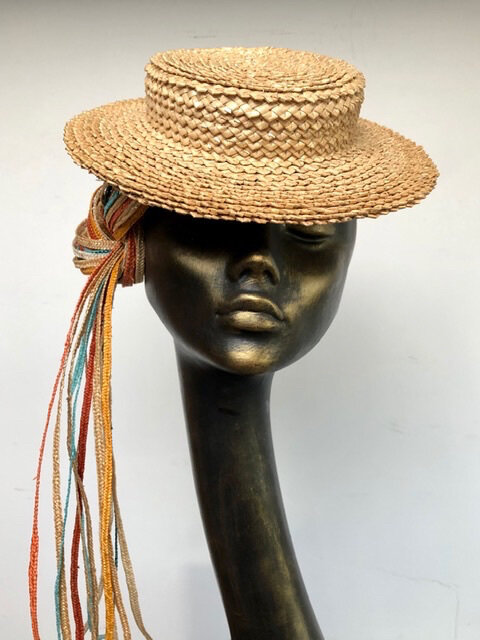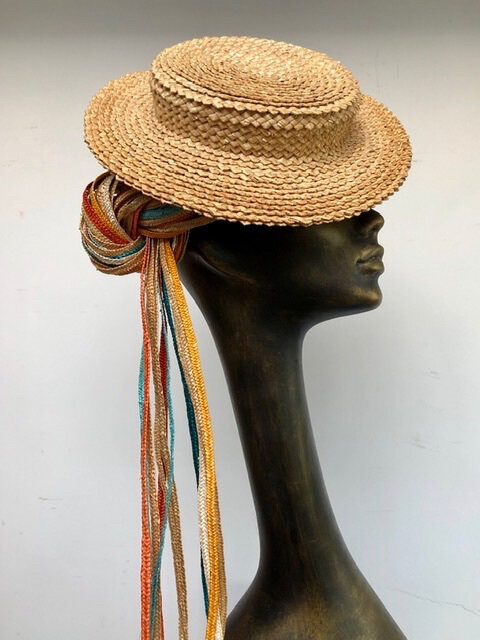Royal Ascot at Home
#StyledWithThanks #RoyalAscot @Ascotracecourse
Royal Ascot is famous around the world for Ladies Day and the amazing array of hats worn by all who attend, but in 2020 Royal Ascot did not go ahead in the usual way. Founder Members of The British Hat Guild worked with Royal Ascot to create hats that were auctioned to raise funds for NHS charities. The hope is that these incredible hats will be worn with pride on Ladies Day next year, 2021. Royal Ascot at Home #StyledWithThanks was launched on Monday 8th June. The online auction was held between 09:00 Tuesday 16th June till 21:00 Saturday 20th June.
Veronica Main is a BHG Founder Member and as a straw plaiter practices a critically endangered heritage trade. Fellow BHG Founder Member, Lucy Barlow is an expert in machine sewing straw plait using traditional methods and the original 17-Guinea machines. Her hat making skills are also critically endangered. See more of Lucy’s work at Instagram @lucybarlow.hats and @hanktohat
Both Lucy and Veronica are Queen Elizabeth Scholarship Holders. This Royal Ascot and British Hat Guild initiative seemed the perfect opportunity for them to collaborate and produce a hat for a very unique situation. This is the story of how they created their hat Brimming with Hope. As with so many projects the time constraints were formidable. From the initial proposal for BHG Founder Members to collaborate with Royal Ascot at Home, to delivery of the finished hat was less than three weeks. Added to this was the complication of lockdown. Thankfully Veronica and Lucy are both passionate about straw. They completely understand the material and share so many design inspirations. From their very first conversations they agreed that they wanted their hat to encompass the industry’s traditions and heritage.
The Concept
A boater shape seemed the perfect choice for this project. The shape needed some soft edges to add femininity and additional elements were required to reflect Royal Ascot at Home’s theme of Rainbows. Veronica and Lucy had great fun looking at various colour combinations before deciding on their final choice.
After many exchanges of messages and sharing of images the concept was born. Now it had to come to life but there were just three weeks to complete the project.
The Straw
Royal Ascot is quintessentially British so Veronica felt the only straw to use for making the plait was a traditional variety of wheat, Maris Widgeon. The pale blonde straw has a hollow stem and works well. Veronica prepared three sheaves of straw that had been grown in Warwickshire - the Heart of England.
The sheaf was cleaned and the stems cut, now they had to be graded into various sizes. A sheaf of wheat will normally grade into five or six thicknesses. Once grading was complete the stems had to be cut into shorter lengths, just 20-25cm long and then the decision made which size of straw to use.
The Plait
Traditionally, the most common plait used for boaters is a four-end straw plait called Rustic therefore this seemed to be the perfect choice. The additional benefit it that is it can be made quickly. For this project speed was of the essence.
Straw can be surprisingly heavy and this hat needed to be lightweight and comfortable to wear. Veronica decided to make a split straw plait. Having made five metres, she realised it would take too long to complete the necessary 20+ metres required. If she continued there would not be sufficient time, so she had to start again using whole straw.
There were problems with this decision since in normal times she would first bleach the straw, a process which softens the straw making the finished plait easier to sew. The only possibility was to make a more pliable plait by using finer straw.
The 16 metres of 10mm wide Rustic plait used approximately 1,400 straws. The five metres of 12mm wide split straw plait used about 300 straws. After the plait was finished the ends had to be clipped and the plait milled several times to make it more flexible.
The Sewing
The plait was sent to Lucy and it was time for her skills to come to the project. Now there were just about ten days until the hat had to be delivered. Whilst waiting for the plait to arrive Lucy had been making some trial boaters to check the shape and size. Her work enabled them to visualise the rest of the design.
The initial plan was for Lucy to machine-stitch the plait using her Victorian 17-Guinea machine. Sadly, it became apparent this would be a little risky in the circumstances. If anything was to go wrong there would not be time to make more plait. There was no other choice, Lucy had to draw upon her considerable experience and skills and hand-stitch the hat body using strong thread and a milliner’s needle.
Starting with the button, it was slow progress. The size had to be regularly checked against the hat block. Sewing the flat crown was relatively fast, but then the plait had to be crisply and quickly turned to form the side. Once that was finished the plait was turned again to form the brim. To add strength a single row edging was added and this was machine-stitched since the 17-Guinea machine needed to be represented on the hat. Lucy used the split-straw plait to create a bandeau again using the 17-Guinea machine. It was so much faster than the hours of hand- sewing!
The Shaping
Once stitched the hat body needed shaping, using steam and pressure Lucy blocked the hat body to give the characteristic shape, then gave a light application of stiffener. Next the bandeau was attached to the hat allowing the headpiece to sit comfortably and securely on the wearer’s head.
The Chignon
Now there were less than two days before the hat was due for photography and submission to Royal Ascot. Time and lockdown meant it was not possible for Veronica to make the plait needed for the chignon and for Lucy to dye it. Instead it was created from imported wheat straw plait hand-dyed by Lucy. So much thought went into creation of the chignon to position and create a good balance. Something that appears so simple requires a lot of skills.
Finally, it was time for the finishing touches of adding the headband.



The Finished Hat
On time, just, the hat was ready for photography. The description was written and a name created, Brimming with Hope. Hope for communities, hope for our carers, hope for the future, hope that Veronica and Lucy can keep these skills alive so they can be handed to the next generations.
The hat was sold and the online auction of all the hats raised over £15,000 for NHS charities. You can find the auction here.





